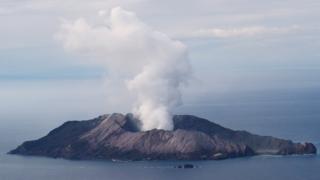

Image copyright
Reuters
Specialist members of New Zealand’s military are preparing to retrieve the bodies of eight victims caught in the eruption of the White Island volcano.
At least eight people have died and many more injured after the volcano exploded, sending scalding steam, ash and rock into the air on Monday.
The authorities said the operation to recover the remaining victims – all presumed dead – would involve getting on and off the island as quickly as possible, with further eruptions remaining a possibility.
What does the mission involve?
Eight specialists from the New Zealand Defence Force will go to the island – also known as Whakaari – at first light on Friday morning local time and “make every effort to recover all bodies”, deputy police commissioner Mike Clement said.
This is despite GeoNet, New Zealand’s geological hazard information site, giving a 50-60% chance of another eruption within the next 24 hours.
Poisonous gases are still billowing from the volcano and the island is blanketed in acidic ash.
The recovery team, who will be flown from a naval frigate to the island, will be kitted out with protective clothing and breathing apparatus.
They face the danger of magma, superheated steam, ash and cannonball-like rocks thrown at supersonic speed should the volcano erupt, GeoNet vulcanologist Nico Fournier said.
During the operation, a geologist will be analysing real-time data to assess whether another eruption is imminent and whether the mission needs to be aborted.
“The risk is not gone,” Mr Clement said. “People are putting themselves on the front line to do the right thing… our thoughts and our prayers and our love will be with them.”
So far, surveillance flights have allowed the authorities to locate six bodies.
Recovering these six would be the priority, Mr Clement said, while there would be limited opportunities to look for the two others.
Any recovered bodies will be taken to frigate HMNZS Wellington, which will be anchored off the coast.
What happened?
On Monday 9 December at about 14:11 local time (01:11 GMT), the volcano on White Island erupted with two explosions in quick succession, flinging ash 12,000ft (3,658m) into the air.
Some 47 people, mostly tourists, were on or near the island when the volcano blew. They came from New Zealand, Australia, China, Germany, Malaysia, the UK and the US.
Moments before it erupted, people – circled below – were seen walking close to its active vent.
Image copyright
XX
Some survivors were rescued by boat in the immediate aftermath of the explosion, but police said it was too dangerous to mount a rescue operation at the time.
Later, helicopter missions launched by local commercial pilots picked up 12 more people – many with severe injuries and burns. They were flown back to the nearby town of Whakatane for medical treatment.
How dangerous is White Island?
Whakaari, located 30 miles (48km) off New Zealand’s North Island, is home to New Zealand’s most active cone volcano.
The uninhabited island is a popular destination for day tours and scenic flights, despite having regular eruptions.
New Zealand sits on the Pacific “ring of fire” – the most seismically and volcanically active zone in the world.
Most of the White Island volcano is below water, with only a 2km-wide portion of the top visible above sea level.
It has seen several eruptions over the years, most recently in 2016, but no-one was hurt.
Although it can be notoriously difficult to know when an explosion might happen, there were warning signs in the weeks prior to the eruption. Last month, the alert level was raised to two, indicating moderate to heightened volcanic unrest.
However, the sudden and dramatic nature of the eruption took people by surprise.
New Zealand police have launched an investigation into the circumstances of the deaths.
Source link







